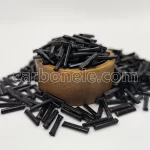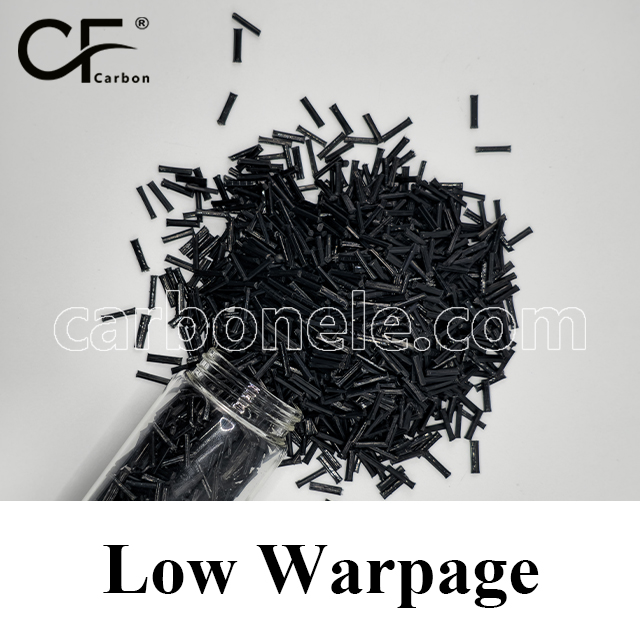
High Performance TPU LCF30 for Sports Equipment
TPU LCF30 has high strength, toughness, wear resistance, chemical resistance, low-temperature flexibility, good processing performance and high dimensional stability.
- Manufacturer: Carbon New Material
- OEM/ODM: Acceptable
- Color: Black
- Free Samples: ≤25kgs
- MOQ: 100kgs
- Port: Xiamen
- Model No.: TPU-LCF-BCA3
- Reinforcing Filler: Long carbon fibers
I. Introduction to TPU LCF30 Composite Material
(I) Composition
The TPU LCF30 composite material is made by using thermoplastic polyurethane elastomer as the base material and adding 30% long carbon fibers as the filling material for reinforcement and modification.
(II) Performance Characteristics
1. High strength: The addition of carbon fibers makes TPU LCF30 have very high strength and can withstand large external forces.
2. High toughness: Retains the high toughness of TPU itself and is not easily broken when impacted.
3. Good wear resistance: Shows excellent wear resistance and prolongs the service life of products.
4. Excellent chemical resistance: Has good resistance to various chemical substances.
5. Good low-temperature flexibility: Can still maintain good flexibility in low-temperature environments.
6. Good processing performance: Can be formed by various processing methods.
7. High dimensional stability: Is not easily deformed during use.
(III) Application Fields
1. Sports equipment field: Can be used to manufacture sports shoe soles, sports protective gear, etc.
2. Automotive parts field: Such as automotive interior parts, seals, etc.
3. Electronic and electrical field: Making electronic product casings, etc.
II. Application Case
In the field of sports equipment, a high-end hiking shoe uses TPU LCF30 composite material to make the sole.
This hiking shoe aims at excellent performance and comfort. Traditional hiking shoe soles usually use rubber materials. Although they are wear-resistant, they are heavy and the support and stability on complex terrains need to be improved. The TPU LCF30 composite material sole perfectly solves these problems.
First of all, the high strength and high toughness of TPU LCF30 provide reliable support for hikers. On rugged mountain roads, the sole can withstand various pressures and impacts and is not easily deformed or damaged. Its good wear resistance ensures that the sole still maintains good performance after long-term use.
During the manufacturing process, Carbon (Xiamen) New Material provides high-quality long carbon fibers to ensure the stable performance of the composite material. This sole is carefully designed with good anti-slip performance and grip, providing safety guarantees for hikers.
At the same time, the good low-temperature flexibility of TPU LCF30 makes hiking shoes maintain good flexibility in cold alpine environments and will not become hard and brittle. In addition, the good processing performance of this material makes the sole more refined in production and improves the quality and aesthetics of the product. Through the successful application on this hiking shoe, TPU LCF30 composite material brings new development opportunities for the sports equipment field.
Distinct carbon fiber reinforced and modified thermoplastic composite raw materials will exhibit variations in performance due to elements like diverse matrix resins, carbon fiber quantity and kind, as well as production techniques. The advantages of specific composite materials still require accurate assessment based on actual application demands and by conducting comparison tests with particular other carbon fiber reinforced plastics. Moreover, thermoplastic composites manufactured by different producers may have different focuses and disparities in performance. If more precise and detailed information is required, it is advisable to refer to the product brochures and technical data sheets of relevant manufacturers or contact us directly.
If you have interest in the materials, please do not hesitate to contact us.
Learn more information on carbon fiber reinforced thermoplastics, please click here.
Roles of LCF in TPU LCF30
Carbon fiber in TPU LCF30 is crucial. It enhances strength and rigidity, gives good wear resistance, improves processing performance. Its low density helps achieve lightweight. Enables applications in various fields like sports and electronics where strength and light weight are important.

How to Contact Us?
Carbon (Xiamen) New Material has a professional and dedicated sales team. Comprised of experienced sales experts, they are well-versed in the features and applications of the company's products. They provide excellent customer service, offering detailed product information and customized solutions to meet diverse customer needs.

Frequently Asked Questions
Carbon (Xiamen) New Material Co., Ltd. aims to provide buyers with "one-stop" worry-free high-quality services. Here you can find all information about carbon fiber engineering plastics. If you still have questions, please send us an email for consultation!
-
How can I contact the manufacturer of a product that interests me?
When you find a product you are interested in, you can contact the manufacturer directly by sending an email and we will get back to you as soon as possible.
-
How do I find the products that interest me?
All you need to do is enter the keyword, product name in the search window and press the Enter key on your keyboard. Your search results page will then be displayed. You can also search within the product category pages on the home page. Each category is divided into subcategories, allowing you to refine your search and find products that interest you.
-
Where will I find a buying guide?
Please contact our after-sales service directly and we will provide you with a comprehensive operating guide.
-
What are CF Reinforced Thermoplastic Composites?
CF Reinforced Thermoplastic Composites are materials where carbon fibers are incorporated into a thermoplastic matrix. They combine the strength and stiffness of carbon fibers with the processability and recyclability of thermoplastics. For instance, they are used in automotive parts like bumper beams.
-
What are the benefits of CF Reinforced Thermoplastic Composites over traditional composites?
The key benefits include faster production cycles, easier recyclability, and better impact resistance. They also offer design flexibility. An example is in the manufacturing of consumer electronics casings where complex shapes can be achieved more easily.
-
How are CF Reinforced Thermoplastic Composites processed?
Common processing methods include injection molding, extrusion, and compression molding. Injection molding is widely used for mass production. For example, in the production of small components for the medical industry.
-
What industries use CF Reinforced Thermoplastic Composites?
They are utilized in aerospace, automotive, medical, and sports equipment industries. In aerospace, they can be found in interior components. In the medical field, they might be used in prosthetics.
-
How does the carbon fiber content affect the properties of the composites?
Higher carbon fiber content generally leads to increased strength and stiffness but may reduce ductility. A moderate content is often balanced for specific applications. For example, a higher content might be preferred in structural parts of a race car.
-
What are the challenges in using CF Reinforced Thermoplastic Composites?
Challenges include higher material costs, complex processing equipment requirements, and ensuring uniform fiber dispersion. Issues with adhesion between the fibers and the matrix can also arise. An example is in achieving consistent quality in large-scale production.
























